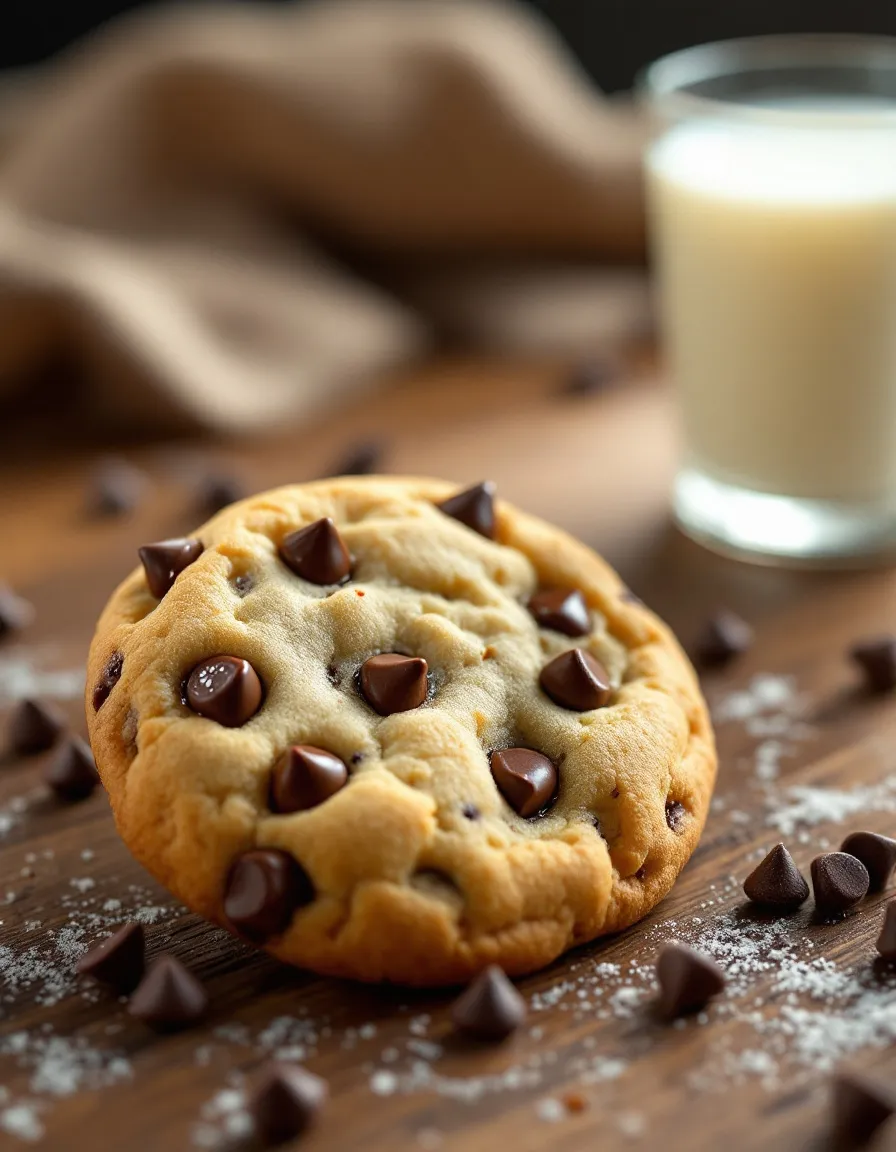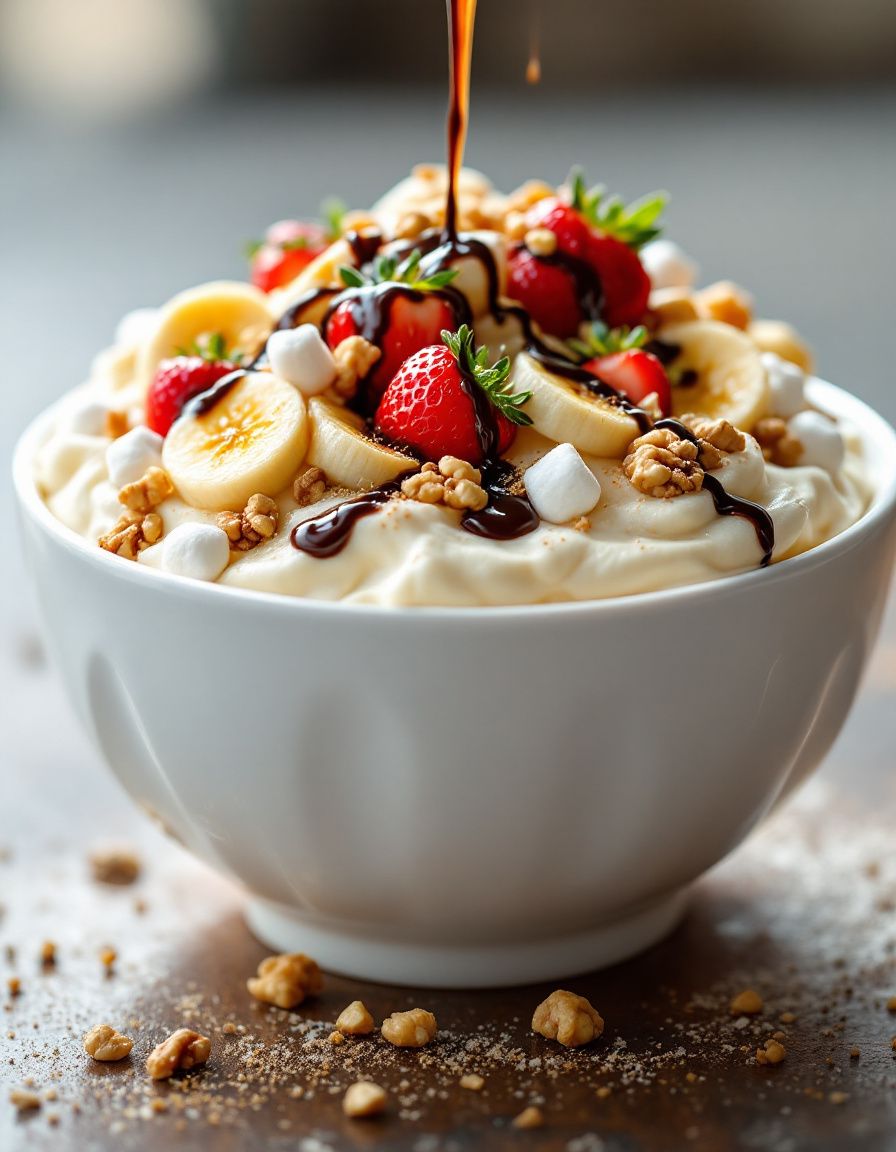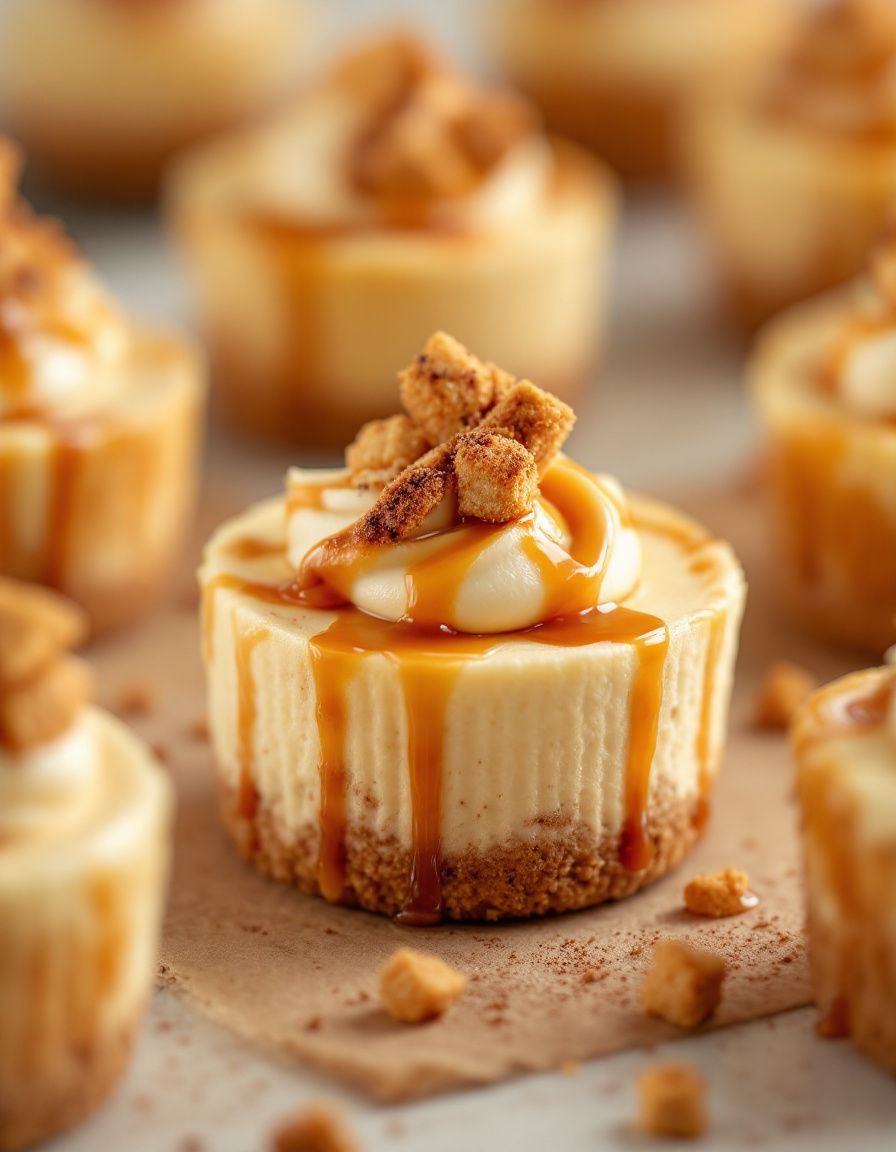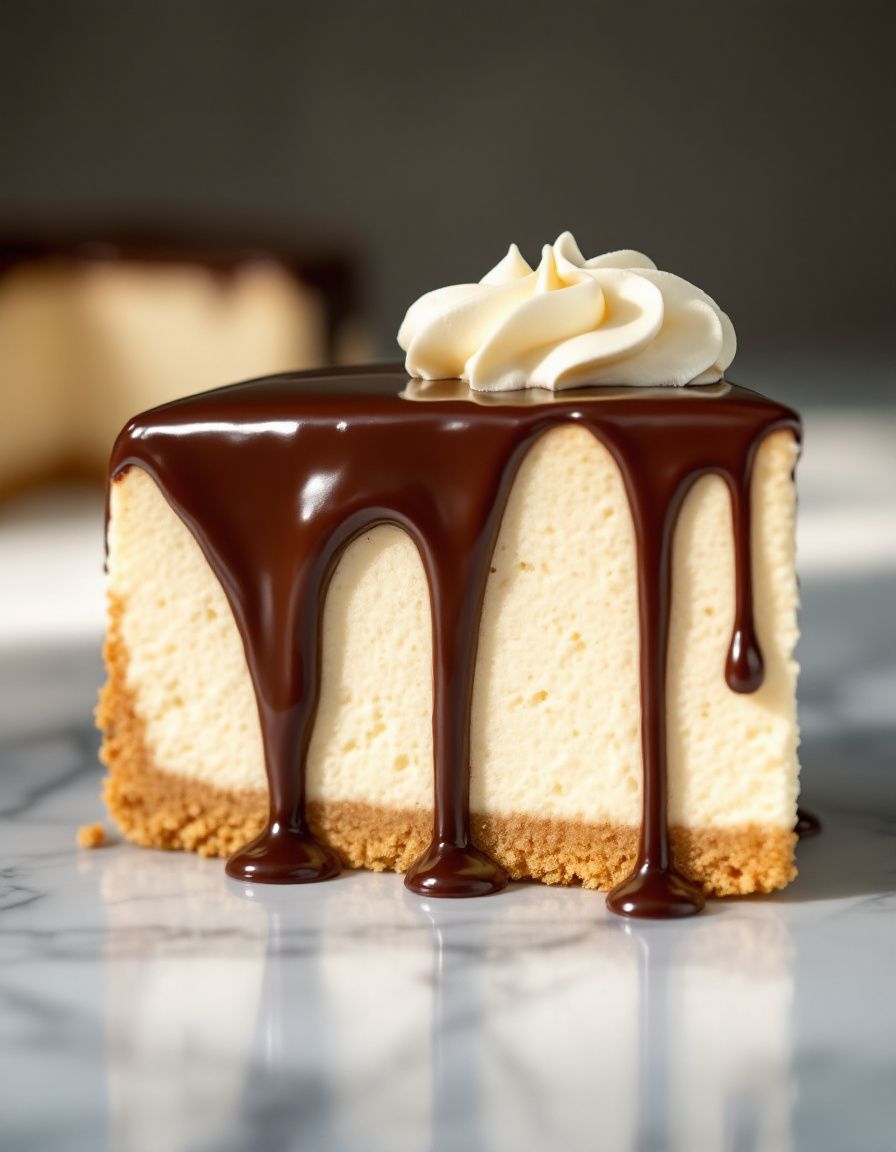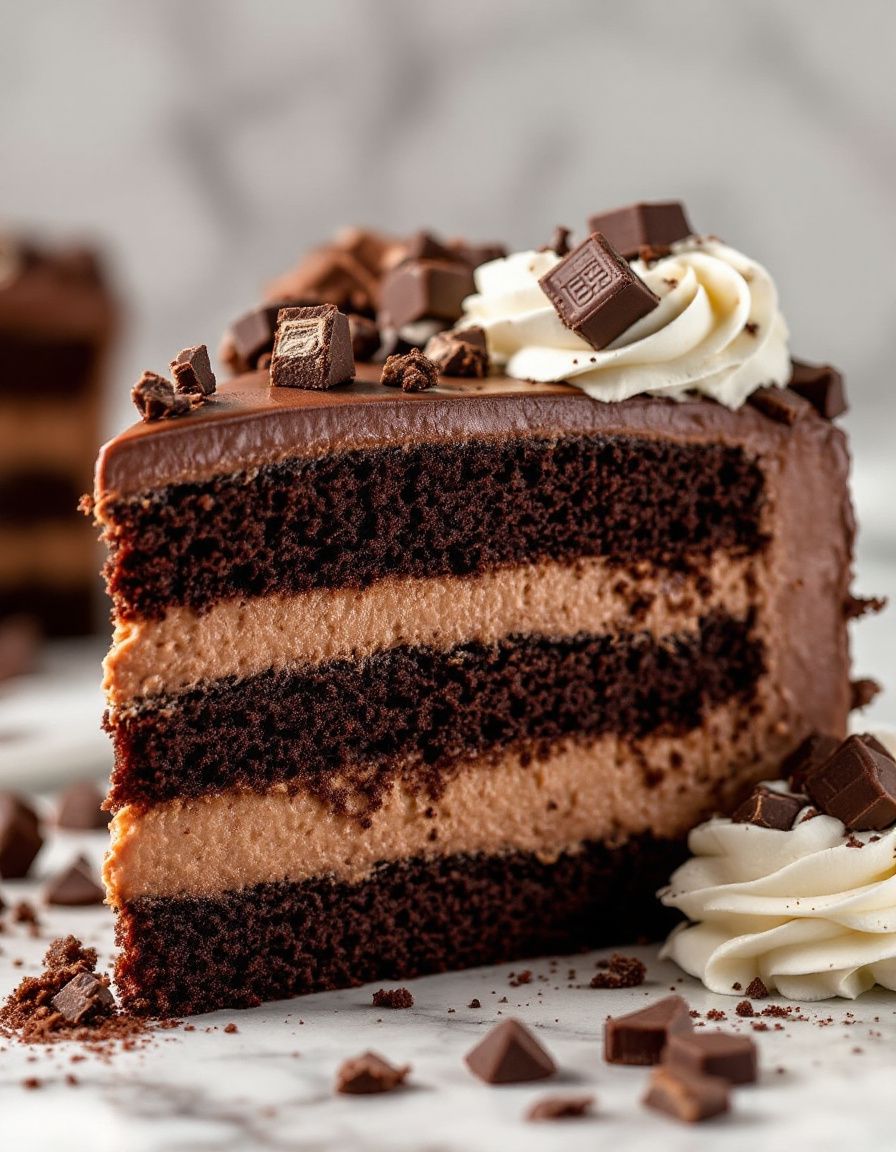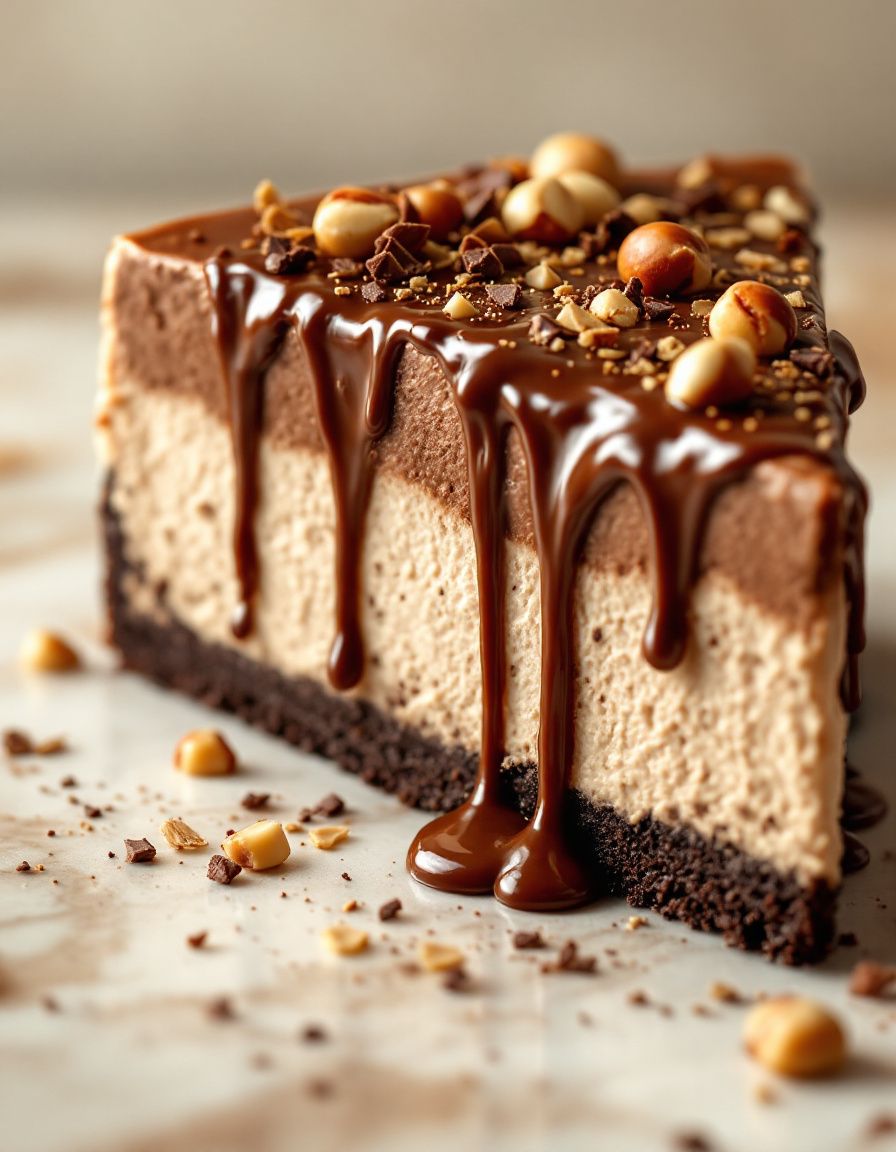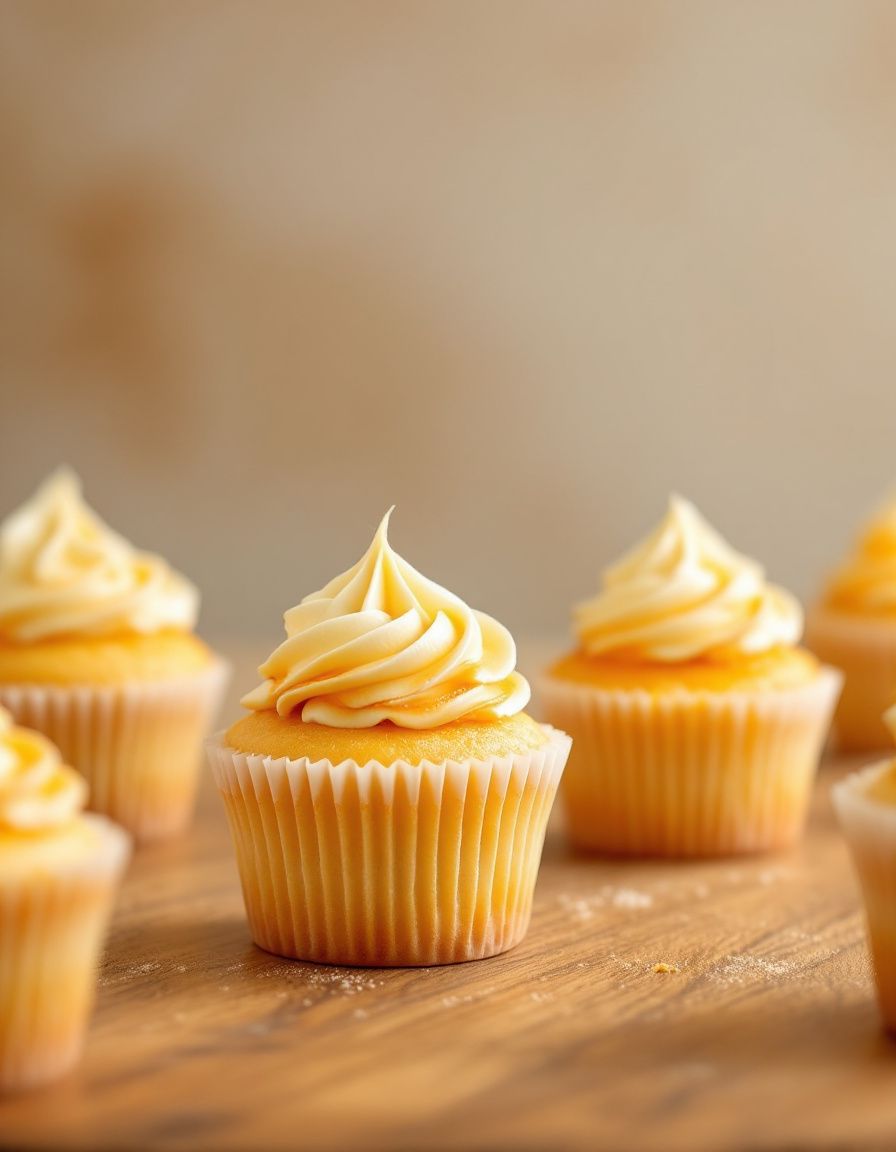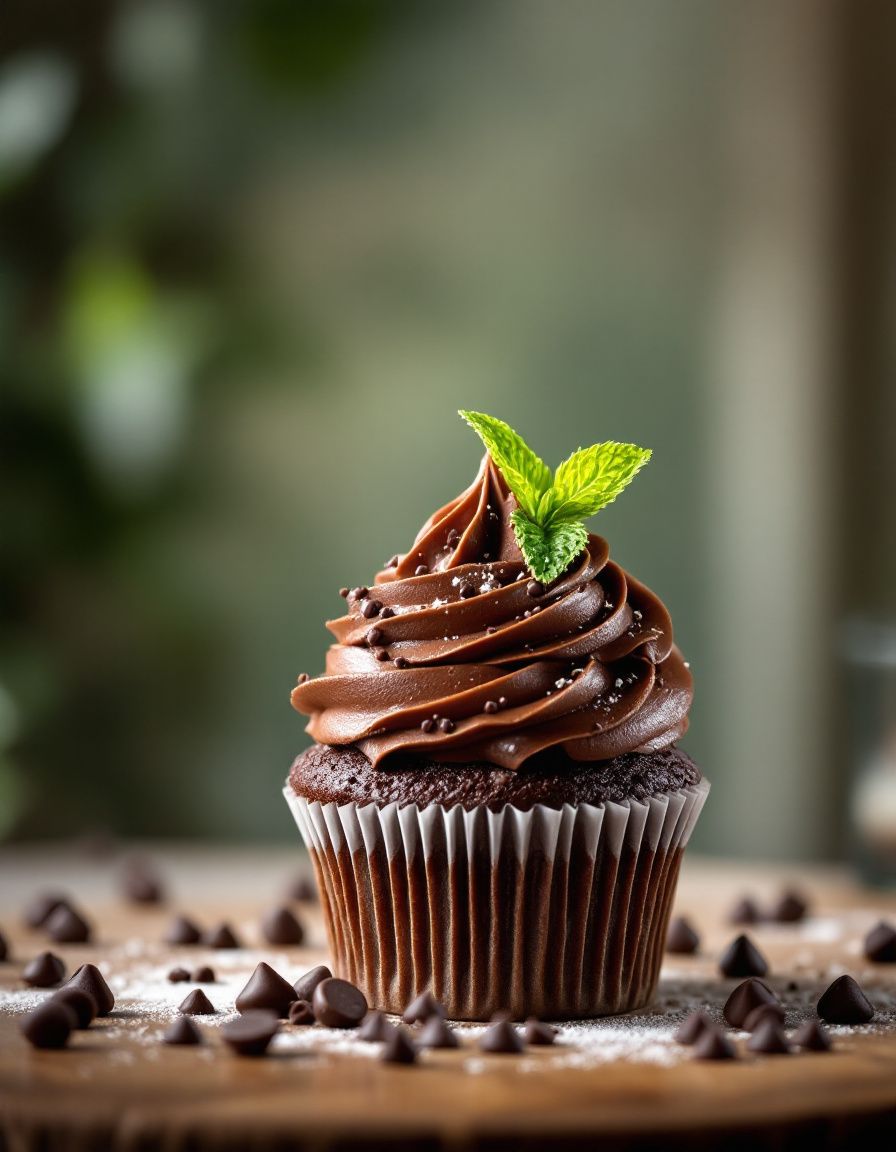Delicious Chocolate Chip Cookies: The Ultimate Comfort Treat
If you’re on the lookout for a classic dessert that feels like a warm hug, you’ve come to the right place. This Chocolate Chip Cookies recipe is not just traditional, but it’s packed with rich flavors and a satisfying chewy texture that will leave you craving more. Imagine biting into a warm cookie, the chocolate chips melting just right in your mouth. This delightful treat has been a staple for generations, bringing smiles to faces, young and old alike.
Chocolate chip cookies evoke nostalgia, family gatherings, and the comforting scent of baking wafting through the home. It’s a recipe that can ignite memories and spark joy, especially when enjoyed fresh out of the oven. With simple ingredients and straightforward methods, you’ll find this recipe not only easy to follow but also rewarding. Get ready to impress your family or guests with these delicious cookies, perfect for any occasion!
Quick Recipe Highlights
- Flavor Profile: These cookies burst with sweet chocolate flavor, beautifully balanced with a buttery richness that complements the dough.
- Texture: Expect a delightful combination of crisp edges and a soft, gooey center, creating an irresistible mouthfeel.
- Aroma: The enticing aroma of caramelized brown sugar and melted chocolate creates an inviting atmosphere in your kitchen.
- Visual Appeal: Golden brown with chocolatey chunks peeking through, these cookies look just as good as they taste, promising deliciousness.
- Skill Level Needed: This recipe is beginner-friendly, requiring only a few simple techniques, making it accessible for all home bakers.
- Special Equipment: You’ll need basic kitchen tools including a mixing bowl, measuring cups, and baking sheets—no fancy gadgets necessary!
Recipe Overview
- Difficulty Level: These cookies are rated as easy, perfect for novice bakers who want to practice their skills and create something delicious.
- Category: This delightful treat falls into the dessert category, ideal for satisfying your sweet tooth at any time of day.
- Cuisine: Originating from American homes, chocolate chip cookies have become synonymous with comfort and family traditions.
- Cost: Inexpensive ingredients make this recipe budget-friendly, allowing you to whip up a batch without guilt.
- Season: Delicious all year round, chocolate chip cookies offer a nostalgic taste that’s comforting in cold winters and delightful in the summer.
- Occasion: These cookies are suitable for various occasions, from holiday gatherings to casual get-togethers and even school snacks.
Why You’ll Love This Recipe
The taste and texture of these chocolate chip cookies are simply unbeatable. Each bite offers a symphony of flavors, from the rich, sweet chocolate to the buttery dough. The combination of crispy edges and a chewy center creates a perfect experience. Once you’ve perfected the art of baking these cookies, they will become your go-to recipe for every gathering and celebration.
One of the most appealing aspects of this chocolate chip cookie recipe is its convenience and ease of preparation. With just a handful of ingredients and minimal steps, even novice bakers can achieve great results. Within 25 minutes—from preparation to baking—you can enjoy fresh, mouth-watering cookies right from your oven.
Nutritionally, while indulging in cookies isn’t the healthiest choice, you can still appreciate the benefits of homemade treats. By incorporating quality ingredients like real butter and pure chocolate, you can ensure a more wholesome snack compared to store-bought options that often include preservatives.
These cookies also hold significant value when it comes to entertaining. The ability to bake a fresh batch fosters connections with friends and family, making them a great addition to any gathering. There’s something truly special about sharing homemade cookies, inviting everyone to enjoy the delightful flavors together, creating fond memories that last a lifetime.
Cost-effectiveness is another reason to love this recipe. Using basic pantry staples, you can make a generous batch of cookies without breaking the bank. These treats are a delicious yet easy way to provide your loved ones with something special without needing to spend a lot on elaborate desserts.
Historical Background and Cultural Significance
The chocolate chip cookie was invented in the United States in the 1930s, originally by Ruth Wakefield at the Toll House Inn in Massachusetts. This popular cookie emerged as an inventive treat when Ruth added chopped chocolate from a Nestlé bar into her butter cookie dough. What started as a kitchen experiment quickly became a favorite and part of American culinary history.
Over the years, chocolate chip cookies have evolved into numerous variations. Different regions have put their unique spin on the classic recipe, from adding nuts to experimenting with caramel or even incorporating oatmeal. Each variation reflects local tastes and preferences, contributing to the widespread popularity of these cookies.
Culturally, the chocolate chip cookie has become a symbol of comfort and home-cooked goodness. It is often associated with family gatherings, school lunches, and holiday celebrations. The mere act of baking these cookies evokes cherished memories and instills feelings of warmth and nostalgia, representing the simple joys of family life.
In today’s society, chocolate chip cookies continue to be a staple dessert, inspiring competitions, cook-offs, and themed festivals. Their allure spans generations and remains a cherished treat for many, showcasing their enduring impact on the culinary landscape.
Ingredient Deep Dive
Butter is a key ingredient, adding moisture and a rich flavor to chocolate chip cookies. It also plays a role in texture, helping achieve that perfect balance between chewy and crispy. When selecting butter, opt for high-quality unsalted varieties to control the salt content in your cookies. In terms of storage, keep butter in the refrigerator and it can last several months if kept in an airtight container. For substitutions, margarine or coconut oil can be used, though adjustments may be needed for texture.
Granulated and brown sugars are also essential for sweetness and texture. Granulated sugar gives a crisp texture, while brown sugar adds moisture and a caramel-like flavor. Selecting fresh, high-quality sugars is crucial for achieving the right taste. These sugars should be stored in airtight containers to prevent clumping. For substitutions, consider coconut sugar for a healthier alternative, but remember that it might alter the final texture slightly.
Chocolate chips are the stars of this recipe, providing luscious bursts of chocolate flavor. Choose quality semi-sweet or dark chocolate chips, as they enhance the overall taste and satisfaction of the cookies. For storage, keep chocolate chips in a cool, dark place to maintain freshness. If you’re looking for alternatives, you could use chopped chocolate bars or even white chocolate chips for a different flavor twist.
Flour provides the structure for our cookies, and using all-purpose flour is ideal for achieving the perfect dough consistency. When selecting flour, ensure it is fresh and unbleached for the best results. Store flour in a cool, dry place, preferably in an airtight container to preserve quality. If you’re in need of a substitute, gluten-free flour blends can work, but the texture may vary.
Eggs act as a binding agent, helping the dough hold together and contributing to the moisture content. Always use fresh eggs for the best quality and flavor. Store eggs in the refrigerator to extend their shelf life. If you need a vegan alternative, consider using flaxseed meal mixed with water or applesauce as an effective egg replacement.
Common Mistakes to Avoid
- Using too much flour: Lightly spoon flour into the measuring cup for accuracy; overpacking can lead to dry cookies.
- Overmixing the dough: Mix until just combined to prevent tough cookies; too much mixing activates gluten.
- Baking from a cold oven: Always preheat the oven before baking to ensure even cooking and proper texture.
- Not chilling the dough: Allowing the dough to chill for at least 30 minutes enhances flavor and prevents spreading.
- Using stale ingredients: Always check expiration dates on your baking supplies for optimal flavor.
- Neglecting to line your baking sheet: Using parchment paper prevents sticking and burning, leading to a better cookie.
- Ignoring baking times: Keep an eye on cookies, as they continue to cook slightly after coming out of the oven.
- Not letting cookies cool: Allow cookies to sit on the sheet for a few minutes before transferring them to a wire rack for the ideal texture.
Essential Techniques
Properly creaming butter and sugars is vital for fluffy cookies. This process incorporates air into the batter, ensuring that your cookies rise beautifully. Aim for a light, pale texture to know you’ve creamed long enough. A common mistake is to rush this step, which results in denser cookies. The visual cue here is lightness and volume.
Measuring flour correctly is crucial for achieving the right dough consistency. Use the spoon-and-level method to avoid excess flour, which can make your cookies hard. This technique involves spooning flour into your measuring cup and leveling it off with a knife. The mistake often made is packing flour into the cup, which can lead to dry results. Your dough should be soft but not sticky for optimal texture.
Chilling the dough before baking is another important step. This helps the flavors meld and prevents cookies from spreading too much during baking. It’s common for bakers to skip this step, leading to flat cookies. The ideal dough is soft but firm, indicating that it’s been chilled properly.
Pro Tips for Perfect Chocolate Chip Cookies
– Use room temperature ingredients for better incorporation; butter and eggs mix more easily as they soften at room temperature.
– Experiment with different types of chocolate to enhance the cookie’s flavor; try using a mix of semi-sweet, dark, or even milk chocolate chips.
– Consider adding a pinch of sea salt on top of the cookies after baking for an elevated sweet and salty flavor profile.
– For a chewy texture, underbake the cookies slightly, allowing them to finish cooking while cooling on the baking sheet.
– Rotate the baking sheets halfway through to ensure even baking, especially if your oven has hot spots.
– Keep extras in an airtight container to maintain freshness, or freeze leftovers for a longer shelf life and later enjoyment.
– Try adding chopped nuts or coconut flakes for additional texture and flavor; walnuts or pecans pair deliciously with chocolate.
– Experiment with add-ins like cranberries or peanut butter chips for diverse taste combinations.
Variations and Adaptations
Chocolate chip cookies can be easily adapted based on personal preferences and dietary needs. For a seasonal variation, consider adding pumpkin spice during autumn or peppermint extract during the winter holidays for a festive twist.
If you’re looking for a healthier adaptation, substitute half of the all-purpose flour with whole wheat flour. This will not only increase nutrition but also add a nuttier flavor. Another option is to use coconut sugar or honey as a sweetener, leading to variations that exhibit different flavor profiles.
For dietary needs, gluten-free alternatives are plentiful, such as almond flour or gluten-free all-purpose mixtures. Additionally, vegan adaptations can be achieved by substituting eggs with flaxseed meal and using dairy-free chocolate chips.
Texture modifications can be achieved by adjusting the flour content; more flour creates a thicker cookie, while less results in a flatter and chewier treat. Finally, try changing the presentation by using cookie cutters to make fun shapes or glazing the tops with chocolate for a decorative touch.
Serving and Presentation Guide
When serving chocolate chip cookies, consider fun plating techniques to enhance the visual appeal. Arrange them in a traditional stack on a plate, or use a tiered stand for an elegant presentation at gatherings. It’s always a good idea to garnish your cookies with a sprinkle of flaky sea salt to elevate the flavor and aesthetics.
Traditional accompaniments for chocolate chip cookies include a glass of cold milk or a scoop of vanilla ice cream, which serves to complement the sweetness beautifully.
Modern serving suggestions might include pairing the cookies with a rich coffee or a warm latte, offering contrast that enhances the chocolate flavors.
Temperature is also key; cookies are best served slightly warm to ensure that the chocolate chips remain gooey and the edges are perfectly crisp. Proper portion control can be achieved by cutting the cookies into pieces, making them perfect for sharing at parties or picnics.
Wine and Beverage Pairing
When it comes to pairing wine with chocolate chip cookies, a dessert wine like tawny port or a sweet sherry complements the richness of the chocolate beautifully.
If preferring non-alcoholic alternatives, consider pairing with rich hot chocolate or a silky chai latte, both of which will blend well with the cookie’s flavors.
For coffee enthusiasts, a dark roast coffee can offer a nice balance against the sweetness, while a rich espresso adds an additional layer of flavor.
Always serve the beverages at the right temperature, with cold milk chugging alongside warm cookies, or hot beverages served steaming to keep the synergy of flavors intact.
Storage and Shelf Life
Proper storage is essential for maintaining the freshness of your chocolate chip cookies. Store them in an airtight container at room temperature for up to a week, ensuring they stay soft and delicious.
For longer storage, consider freezing them. Wrap each cookie individually in plastic wrap and place them in a resealable bag, where they can last up to three months.
When thawing cookies, simply leave them out at room temperature or warm them briefly in the microwave for a few seconds for that fresh-baked taste again. Always check for signs of spoilage; if you notice any off-smells or changes in texture, it’s best to discard them.
For reheating, use the oven instead of the microwave for optimal crispness; place them on a baking sheet at 350°F for about five minutes.
Make Ahead Strategies
Making chocolate chip cookie dough in advance is an excellent strategy for saving time later. You can prepare the cookie dough, then wrap it tightly in plastic and refrigerate for up to three days or freeze it for longer.
When ready to bake, you can either slice off portions of the frozen dough or scoop and place them on the baking sheet directly from the fridge.
To preserve the quality, make sure to label your stored dough with the date for easy tracking. It’s also beneficial to check the cookies frequently as they bake, especially if they come from chilled or frozen dough, as baking times may vary slightly.
Consider adding freshly chopped nuts or an extra sprinkle of sea salt just before baking to rejuvenate the flavors, ensuring each batch is as enjoyable as the last.
Scaling Instructions
When scaling this chocolate chip cookie recipe, precise measurements are crucial. For halving the recipe, remember to adjust the quantities accurately to maintain balance in flavor and texture.
If doubling or tripling, consider the capacity of your baking sheets; you might need to bake in batches, ensuring even baking time is maintained.
Changes in ingredients may also require slight timing adjustments during baking; always keep an eye on the cookies and test periodically, especially with larger volumes.
For any size of batch, ensure a consistent mixing process to avoid uneven flavors, and don’t forget to manage storage thoughtfully when working with large quantities.
Finally, letting the dough rest will only enhance flavors, so adequate chilling time should remain a priority even with larger batches.
Nutritional Deep Dive
When considering nutrition, each chocolate chip cookie typically contains around 150 calories, largely reflecting its carbohydrate content due to the sugars and flour used.
With 2 grams of protein per cookie, it might not be a significant amount, but when paired with a glass of milk, it can contribute to a balanced snack in moderation.
Micronutrient-wise, cookies contain small amounts of calcium and iron from the sugars and chocolate. However, it is essential to remember they are primarily simple carbohydrates, making moderation key for a healthy diet.
In terms of portion analysis, a two-cookie serving may satisfy a sweet tooth, yet conscious eaters should keep in mind their overall daily intake to match personal dietary goals.
For weight management, consider the potential effects of treats on overall caloric intake; homemade cookies can provide enjoyment without the over-processing associated with store-bought options.
Dietary Adaptations
Those looking for gluten-free options can easily customize this cookie recipe by utilizing almond flour or a certified gluten-free all-purpose flour blend. Keep the texture similar by adjusting the wet ingredients slightly to achieve a uniform dough.
For a dairy-free variant, use coconut oil instead of butter and select dairy-free chocolate chips. This adaptation still maintains the cookie’s signature taste while catering to lactose intolerance and vegan diets.
Individuals following a low-carb or ketogenic diet often look for sweet alternatives; using almond flour and sugar substitutes such as erythritol can create a delicious keto-friendly cookie, marrying flavor with dietary needs.
Vegan adaptations can also be easily executed by replacing eggs with flaxseed meal mixed with water, producing an egg-free cookie that’s both scrumptious and plant-based.
Alongside these modifications, exploring paleo-friendly options using coconut flour and honey allows lovers of natural ingredients to indulge guilt-free.
Troubleshooting Guide
Texture issues can arise if too much flour is added. To remedy this, always spoon flour into your measuring cup and level it off for accuracy. If cookies turn out too dry, consider adding a teaspoon of milk to the dough to create balance.
Flavor balance can be adjusted by adding a pinch of salt, enhancing the sweetness of your cookies and helping prevent them from tasting flat.
Temperature problems may occur if your oven runs hot or cold; invest in an oven thermometer to ensure accurate temperatures. If your cookies are burning, decrease the temperature and check the baking time, especially for larger batches.
Equipment challenges can arise if your mixer struggles with the dough’s thickness; mixing by hand can sometimes yield better results in terms of control.
If a previously reliable baking sheet begins sticking, line it with parchment paper to save your cookies from losing half their texture when removed.
When it comes to timing concerns, cookies baked too long can become hard; always remember they’ll continue cooking slightly after removing from the oven.
Recipe Success Stories
The chocolate chip cookie recipe has garnered numerous success stories from home bakers worldwide. Many have shared personal adaptations, like substituting peanut butter for half the butter or adding caramel bits, making their versions unique.
Community feedback includes raving about the chewy texture achieved when correctly following the resting and chilling techniques. Numerous bakers have praised the transformative experience this recipe offers, solidifying it in their family traditions.
Photography tips shared by enthusiastic bakers highlight the importance of natural light when capturing those golden treats straight from the oven, ensuring the beauty of your creations is showcased prominently.
Some readers recommend pairing their baking sessions with a family movie night, turning cookie making into a cherished family activity that creates lasting memories.
Frequently Asked Questions
Can I make the dough ahead of time?
Yes! You can prepare the dough in advance and store it in the refrigerator for up to 3 days or freeze it for longer. Just make sure to let it soften slightly before baking.
What can I use instead of eggs?
If you’re looking for an egg substitute, try mixing 1 tablespoon of flaxseed meal with 2.5 tablespoons of water. Let it sit for a few minutes to thicken before adding to your dough.
How do I prevent cookies from spreading too much?
Chilling the dough for at least 30 minutes before baking can help prevent spreading. Additionally, ensure your butter isn’t too soft when you start mixing.
Why are my cookies too hard?
If your cookies turn out hard, you may be over-baking them or using too much flour. Make sure to check cookies a minute or two before the recommended time.
Can I use whole wheat flour?
Yes, you can substitute half or all of the all-purpose flour with whole wheat flour for a nuttier flavor and added nutrition.
How should I store leftover cookies?
Store your cookies in an airtight container at room temperature for up to a week, or freeze them for longer storage.
Can I add nuts to the recipe?
Absolutely! Chopped nuts like walnuts or pecans pair wonderfully with chocolate chips and add extra texture.
What’s the best type of chocolate to use?
Semi-sweet and dark chocolate chips are classic choices that provide a nice balance of sweetness and richness.
Are these cookies vegan-friendly?
To make these cookies vegan, substitute butter with coconut oil and use a flaxseed mixture instead of eggs.
What if I don’t have chocolate chips?
You can use chopped chocolate bars or any chocolatey alternatives like butterscotch chips or white chocolate chips.
What temperature should I bake cookies at?
The ideal baking temperature for chocolate chip cookies is generally 350°F. Always preheat your oven properly before baking.
How can I make chewier cookies?
For chewier cookies, slightly underbake them and consider using a higher ratio of brown sugar to granulated sugar.
Additional Resources
Looking for more delicious treats? Check out related recipes for oatmeal cookies, snickerdoodles, or even brownies to satisfy your sweet cravings!
Explore technique guides on proper cookie decorating, batch baking, and ingredient substitutions for your favorite recipes. For a deeper dive, consider learning about the different flour types and their unique properties in baking.
Equipment recommendations? A good quality stand mixer can save time and improve consistency in your cookie creations, making it a worthy investment for any home baker.
Stay updated on seasonal variations by incorporating fruits, nuts, and spices throughout the year, adjusting your ingredients to reflect what’s in season for the freshest flavors.
Join the Conversation
We’d love to see your baking adventures! Share your chocolate chip cookie creations on social media and tag us in your posts. Join our community discussions to exchange tips and personal variations with fellow cookie enthusiasts.
If you have a fabulous idea for a twist on the classic recipe or a memorable baking experience, we invite you to share it! Your feedback and suggestions help foster a positive and engaging environment around the love for baking.
Together, let’s celebrate the joy and comfort that a simple chocolate chip cookie can bring into our lives!
The Recipe
Chocolate Chip Cookies
Serves: 24 cookies
Prep Time: 15 mins
Cook Time: 10 mins
Total Time: 25 mins
Kitchen Equipment Needed
- Mixing bowl
- Measuring cups
- Baking sheets
- Silicone spatula
- Wire cooling rack
Ingredients
- 1 cup unsalted butter, softened
- 3/4 cup granulated sugar
- 3/4 cup packed brown sugar
- 1 teaspoon vanilla extract
- 2 large eggs
- 2 1/4 cups all-purpose flour
- 1 teaspoon baking soda
- 1/2 teaspoon salt
- 2 cups semi-sweet chocolate chips
Directions
- Preheat your oven to 350°F (175°C) and line baking sheets with parchment paper.
- In a mixing bowl, cream together the softened butter, granulated sugar, and brown sugar until light and fluffy.
- Add the vanilla extract and eggs, one at a time, mixing well after each addition.
- In another bowl, whisk together the flour, baking soda, and salt.
- Gradually add the dry ingredients to the wet mixture, stirring until well combined.
- Fold in the chocolate chips until evenly distributed throughout the dough.
- Scoop tablespoon-sized amounts of dough onto the prepared baking sheets, spacing them about 2 inches apart.
- Bake in the preheated oven for 9-11 minutes or until the edges are golden brown.
- Remove from the oven and allow the cookies to cool on the baking sheets for 5 minutes before transferring them to a wire rack to cool completely.
Recipe Notes
- For a chewier cookie, underbake slightly.
- Add chopped nuts or use different types of chocolate for variety.
- This dough can be refrigerated for up to 3 days or frozen for up to 3 months.
